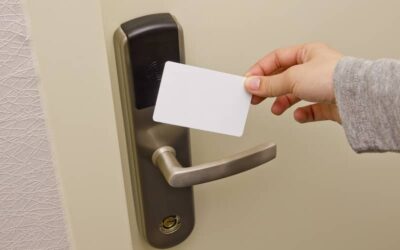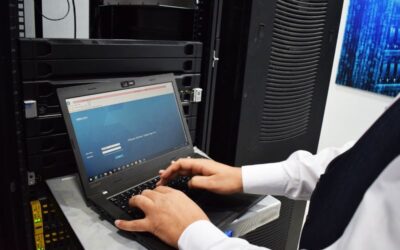When you think of access control, you might picture keys or swipe cards for authenticating users. However, these systems are much more sophisticated today. Modern access control systems use various credentials to verify identity and grant access to secure spaces.
So, which access control credential should you choose? Let’s explore your options and weigh their pros and cons to help you find the best solution for your security needs.
1. RFID
RFID, or radio frequency identification, is a popular access control credential that uses radio waves to identify and track objects. Unlike traditional keys or swipe cards, RFID systems consist of two main components: tags and readers. Tags can be active, semi-passive, or passive. Passive tags rely on the reader’s signal for power and work well at close range. Active tags have their own power source, allowing for longer-range communication.
RFID technology is versatile and widely used across various industries, from inventory management to retail and logistics. It offers the advantage of contactless entry for quick and efficient user authentication. Companies mostly use RFID cards and fobs to manage access, choosing from basic proximity cards to advanced smart cards that provide security through encrypted communication.
2. Biometric
Biometric access control systems use unique physical characteristics like fingerprints, facial recognition, or iris scans to verify identity and grant access. Unlike traditional keys or cards, biometric credentials cannot be easily duplicated or lost. Security managers can also adjust the sensitivity and threshold settings of biometric readers to ensure the right balance between security and user convenience.
Security and convenience is measured by two factors: the false acceptance rate (FAR) and the false rejection rate (FRR). FAR occurs when an unauthorized person is mistakenly granted access. FRR happens when an authorized person is wrongly denied entry.
In highly sensitive environments like data centers, minimizing FAR to prevent unauthorized access is the goal. This might mean accepting a higher FRR, where legitimate users might occasionally face access issues. The right balance between the two depends on the specific security needs of your facility and your willingness to accept the associated risk.
3. Pin Codes
PIN codes are numeric passwords that users enter to gain access to secure areas or systems. Typically, PIN codes are four to six digits long, but they can vary based on the system’s security requirements.
PIN codes are suitable for environments where managing physical keys or cards is impractical. Employees appreciate the convenience of memorizing a code rather than carrying an access card. With PIN codes, users simply approach a keypad, enter their assigned numerical code, and gain access to the space.
4. Mobile Credentials
Mobile credentials are digital keys stored on mobile devices, typically within a dedicated app. These credentials use technologies like Near Field Communication (NFC) or Bluetooth Low Energy (BLE) to communicate with access control systems. As long as the device is compatible, users can unlock doors with a tap or a gesture on their phone.
Mobile credentials are an attractive choice for access control because they offer the convenience of multi-factor authentication by leveraging a phone’s PIN or biometric features like fingerprints or facial recognition. It adds an extra layer of security without the need for additional devices.
5. Proximity Cards
Proximity cards are contactless cards that use RFID technology to communicate with card readers. They are commonly used in office buildings and other secured environments where quick and easy access is necessary. Users simply hold the card near the reader to gain access.
While proximity cards are convenient, they are less secure than smart cards and can be vulnerable to cloning unless used alongside with additional security measures.
6. Smart Cards
Smart cards are a modern access control solution that includes an embedded microchip. This microchip stores and processes data, enabling secure communication with access control systems. Unlike basic proximity cards, smart cards offer higher security through encryption and mutual authentication.
Smart cards are also versatile and can store multiple credentials on a single card. This often means employees can just use one card for building access, computer logins, and even payment systems. Smart cards are used in a variety of industries where security is a top priority, including government, healthcare, and corporate settings.
How to Choose the Right Access Control for Your Needs
Choosing the right access control system depends on several factors. Consider the security level required, the convenience for users, and the overall cost. Each credential type has its strengths and weaknesses, so understanding your specific needs will help you make the best choice.
- Security Requirements: Evaluate how secure the space needs to be, considering whether it houses sensitive data or equipment. Higher security levels might require multi-factor authentication.
- User Convenience: Consider how easy the system is for users to access regularly. Simple methods might be sufficient for frequent access, while sensitive areas need robust security.
- Cost Considerations: Assess both the initial setup costs and ongoing maintenance expenses. RFID and PIN systems may cost less upfront, but biometrics can offer longer-term savings.
- Scalability and Flexibility: Look for a system that can grow with your business. Choose technology that can integrate with existing systems and adapt to future needs.
- Installation and Maintenance: Think about the complexity of installation and the technical support required. Some systems are plug-and-play, while others need professional setup and regular maintenance by a Salt Lake City IT services provider.
- Integration with Other Systems: Determine how well the access control system integrates with your current security and IT infrastructure. This ensures seamless operation and data management.
- Regulatory Compliance: Check for compliance with industry regulations and standards. Certain industries, like healthcare and finance, have specific access control requirements.
By carefully considering these factors, you can select an access control system that effectively meets your security and operational needs.
Conclusion
Business data and systems are high-value targets for bad actors worldwide. Securing yours with access control will help protect your assets. Remember, choosing the right system involves balancing security, convenience, and cost. Whether you’re using on-premise or cloud based access control, keep these criteria in mind to make the best decision for your organization’s needs.



